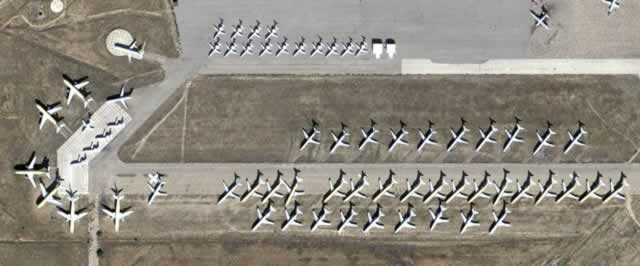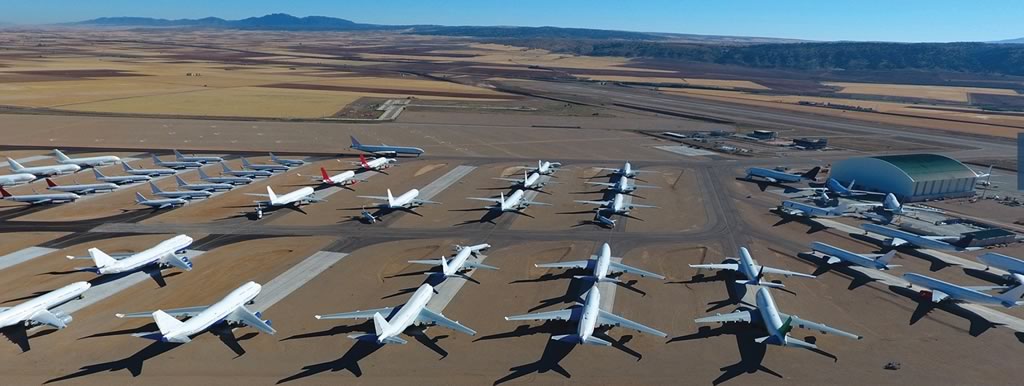
Grounded Airliners in Storage During the COVID-19 Pandemic Outbreak
Fluctuations in the world economy can force airlines to temporarily store their jetliners until their return to active service. And global events such as the COVID-19 outbreak in 2020 and 2021 can ground airline fleets.
All commercial airliners have limited lifespans due to airframe wear and/or obsolescence. Ultimately, they must be retired from service, stored in "airplane boneyards" or graveyards, and finally dismantled and scrapped. Others are kept for spare parts for flying aircraft.
Some jetliners are temporarily taken off flying status, and must be stored in a environment that is conducive for preservation until a return to service.
To protect airliners during long-term storage from wind and sun damage, engines and windows are tightly covered with white, reflective materials. A sealed airliner can thus be stored safely, for years, until the time comes to return it to active duty, or salvage.
Airliner boneyards & storage facilities in the western USA serve several functions: temporary storage, maintenance, parts reclamation, and scrapping.
Similar facilities exist around the world at airplane boneyards in Europe and Australia.
Airliner Storage During the COVID-19 Outbreak
As anyone that flies, has ties to the aviation industry, or watches TV knows, the worldwide outbreak of the Coronavirus in 2020 and 2021 had a major negative impact on airlines and their fleets, worldwide.
Thousands of airliners were placed in storage around the world. Estimates are that nearly 17,000 airliners were idled at the peak downturn due to the COVID-19 pandemic. Trade group Airlines for America (A4A) estimated that nearly 20% of U.S. airline fleets, nearly 1,000 aircraft, were in long-term storage as of October 25, 2020.
As conditions have improved in 2022 and 2023, many airliners have been removed from storage and placed back into active service.
Major air carriers such as American Airlines, Delta Air Lines, British Airways, United Airlines, Lufthansa, Virgin Atlantic, Cathay Pacific, Qantas and others had to eliminate flights due to lack of demand, and store hundreds of jetliners until their return to service.
Permanent Retirement
Permanent retirements of some older aircraft such as Boeing 757s and 767s, MD-88s, Airbus A340-600s, and Airbus A380s were accelerated during 2020. Some airliner retirements slated for 2021 or beyond were moved forward.
Temporary Storage at Active Airports
 |
Many airliners were stored at airports in the United States such as Pittsburgh, Tulsa, Atlanta, SkyHarbor in Phoenix, Mobile, San Antonio and Birmingham. In some locales runways and taxiways have been converted to parking areas.
In Europe, airliners were parked at airports in Frankfurt, Copenhagen, Paris Vienna, and London, among others.
Other airports around the world at which aircraft were parked include Seoul, Hong Kong, Sydney, Melbourne, Brisbane and Delhi.
Long-term Storage at U.S. Boneyards
Other airliners were sent to full-scale storage facilities such as these in the United States.:
Southern California Logistics Airport in Victorville
Long-term Storage in Europe & Worldwide
Longer-term and temporary parking facilities in Europe and Australia are also providing storage services to the airlines:
Tarbes-Lourdes-Pyrenees Airport in France
Overhead view of dozens of airliners parked at the TARMAC Aerosave facility at the Teruel Airport in Spain (photo courtesy of TARMAC Aerosave) |
 |
British Airways Airbus A380s in temporary storage at the Chateauroux Airport in central France |
|
Asia Pacific Aircraft Storage at the Alice Springs Airport in Australia (photo courtesy of APAS) |
 |
Where Airliners Go to Die ... and Be Recycled
Are You an Airliner Spotter?Identification of individual aircraft manufacturers and airliners can be difficult with the wide variety of jet airliners in service around the world. Our new website features Spotting Guides and photographs of common jet airliners in the fleets of airlines today. We focus on jet airliners from Boeing, Airbus, Embraer and Bombardier, even Antonov. |
Map of locations of major airplane boneyards and storage facilities Around the World



